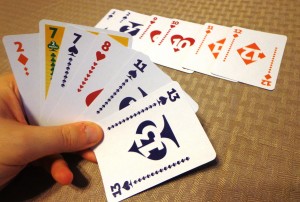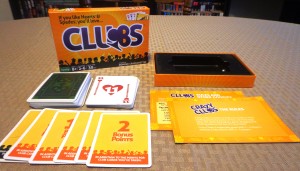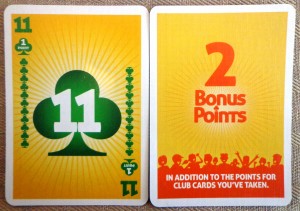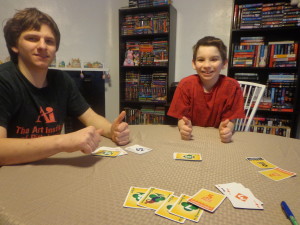North Star Games has always come through for us one way or another, especially when the kids feel the need to get silly (which happens often). “Say Anything” and “Crappy Birthday” are regular hits, with the occasional “Wits & Wagers” thrown in for good measure. Needless to say that I was surprised by “Clubs” as it wasn’t the kind of game I’d have expected from North Star Games considering the pattern. While hundreds upon thousands of card game variants exist (officially or unofficially), I hadn’t seen one yet that focused on the suit of clubs…until today. “Clubs” tasks players with getting rid of all of their cards quickly while trying to collect the only suit that will score them points…you guessed it, clubs. Before we take a look at this particular card game, I’d like to thank Matt Mariani from North Star Games for providing me with a free review copy.
Components
Playing Cards – The game includes one deck of playing cards that consists of four suits, each with a value range from one to fifteen.
Bonus Cards – These six cards have a single value on them and are awarded to players as they go out during a round. They are valued at “0”, “2”, “5”, “8”, “10”, and “12”.
Pencil and Paper (Not Included) – Players will need a way to keep score when points are tallied at the end of a round.
Setup & Gameplay
First, players will place the appropriate number of bonus cards face-up onto the table. The number and values used will change, depending on how many people are playing the game. Next, players randomly choose a dealer and that person deals ten cards to each player. The person to the left of the dealer goes first or “leads.”
The leader, or the person playing first, plays a “meld” of their choice near the center of the table. A meld is considered to be either a one/two/three-of-a-kind (3, 55, 777) or a run of two or four (23, 3456). Once this occurs, players must follow the pattern of this meld in their plays until the “trick” (the pile of cards accumulating in the center of the table) is won. Melds played throughout the round must not only be in the same pattern as the leader’s meld, but the highest value in a meld played must be higher than the previous meld. A player can pass if they so choose, and doing so does not eliminate them from playing on their next turn.
Winning a trick is done by playing a meld with a “15” in it, or when all players pass consecutively. The winner of the trick takes all of the cards played, puts them into a score pile, and becomes the new leader. Players will continue leading, melding, and winning tricks until players start running out of cards. The first person to go out receives the highest valued bonus card, and so on and so forth until the “0” bonus card is taken. Players who go out and receive a bonus card do not play for the rest of the round (they have no cards). Once the “0” bonus card is taken, the round ends, and points are tallied. A player’s score is equal to the points listed on their club cards (not their face value!) plus their bonus card value. The player who gets the “0” bonus card does not receive points for the clubs they won.

I didn’t have a run of two to play any further and was forced to pass. Luckily, no one scored clubs this round.
Players continue to play rounds until someone scores fifty points or more. The person with the most points after this occurs is the winner! There’s a few things I didn’t mention, but that should give you a basic understanding of how the game is played. For more information, please check out the links at the end of this article.
Editor’s Note: I just wanted to add that leaders are not limited to one/two/three of a kind or runs of two and four, like the manual states as examples. Leaders can play four of a kind or create runs of any length. Thanks to Luke from North Star Games for clarifying.
The Review
First, I have to compliment the cards for being colorful and easy to read. Old eyes like mine hate it when they have to squint. I admit that I had to read the rules a few times to get used to all of the different terms: melding, tricks, etc. Thankfully, the manual includes definitions to all of these terms and even has a page dedicated to sample plays. I must admit that without them, I’d have been a little lost.
I also appreciate the number of variants that are included with the game. The manual lists special rules for two players, adds the ability to make fifteen’s wild, and includes rules for partnership play. A special insert lists rules for “Crazy Clubs”, which allows players to continue playing when someone plays a “15”. The two player variant is easy to implement: only the “5” bonus card is used and is rewarded to the first person to go out. The other player still receives club points, but no bonus points. In any of these variants (or in the regular game), players can claim “double or nothing” at the beginning of a round. If they are the first person to run out of cards, they receive double the points they’ve earned. Otherwise, they score nothing. All of these different rules and variants will keep things interesting long after the first game is done and over with.
Vinnie (11) had a tough time at first understanding how all of the rules came together. It was confusing for him (as it was for me at first) in how leads, plays, and tricks all came together to form a single round. Once he overcame the learning curve, he was quickly getting into the spirit of the game and attempted to get rid of all of his cards as quickly as possible. What he didn’t take into account was the “press your luck” factor that the game features. While a player does earn more bonus points for going out first, they stop earning clubs for the rest of the round. A player who goes out second or third might be able to collect more clubs and net a higher score, even with the lower bonus card factored in. It all depends on how the cards are dealt and played, giving players a lot to consider from game to game. As players start seeing more and more clubs being awarded in tricks, they’ll benefit less from staying in play, just as an example.
Anthony (17) was a bit more strategic in his play, as he played complicated runs and pairs as often as he could when he was leading. At some points, he was able to run the board and deplete his hand quickly, since everyone else was forced to pass and couldn’t keep up with this combinations. Playing with three players was a bit more random, since only about half the deck was used in one round. This meant that we, as a group, had no idea which clubs or what high cards would be in play during the round. Counting cards did little good, so I was forced to play complex runs like Anthony and hope to picked up some clubs in the process. I’d save my fifteens for when someone played a low club card or two, which nets a lot of points. In the end, I won with fifty-two points to Anthony’s thirty-one and Vinnie’s eighteen.
Overall, “Clubs” is a fantastic family-friendly game. It is easy to pick up and play, and the low number of components (it’s just a deck of cards) makes cleanup a cinch. It’s portable enough to bring with you on vacations, or to a friend’s house for game night. Play can be as quick or as long as you like it to be. If you want a longer game for example, you can extend the points needed to win to a value of your liking. If you’re playing with two or three players, you could increase your hand limit for a faster game. The variants add to the game’s replayability…I’m sure the partner variant will be popular among adult couples who game together regularly. The official website mentions that the game will be available in April 2013, though I discovered a few available via the below Amazon link as of 3/28/13. The price listed there is $14.99, which isn’t bad all things considered. Most card games I see in stores like “Monopoly Deal” and etc. clock in around eight or nine bucks, so some might be put off by the higher price tag. Still, if the price is right for you, then I recommend picking it up.
Final Verdict: 9/10
—
You can learn more about and purchase “Clubs” by visiting the following websites:
http://www.northstargames.com/North_Star_Games/Clubs.html
http://boardgamegeek.com/boardgame/125924/clubs
—




Vinnie,
Great review as always. Just want to clarify that runs can be of any length and you can also play 4 of a kind.
Glad your kids picked it up so quickly and started figuring out the strategic play. That is how we tried to design it.
Hi Luke!
Thanks for clarifying! I thought as much, but didn’t want to stray too far from the manual in case I was wrong. I added an editor’s note right before the review portion. 🙂